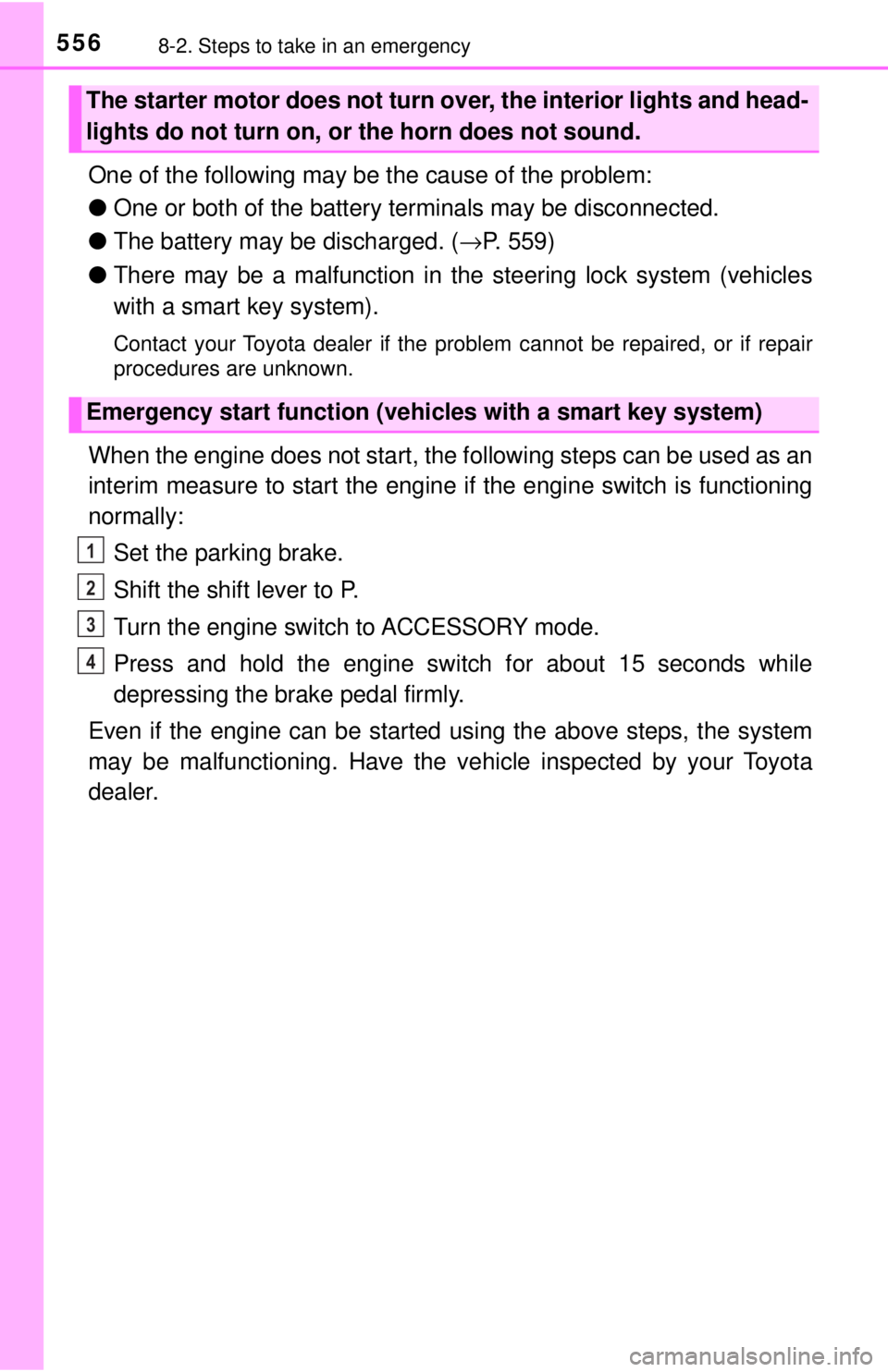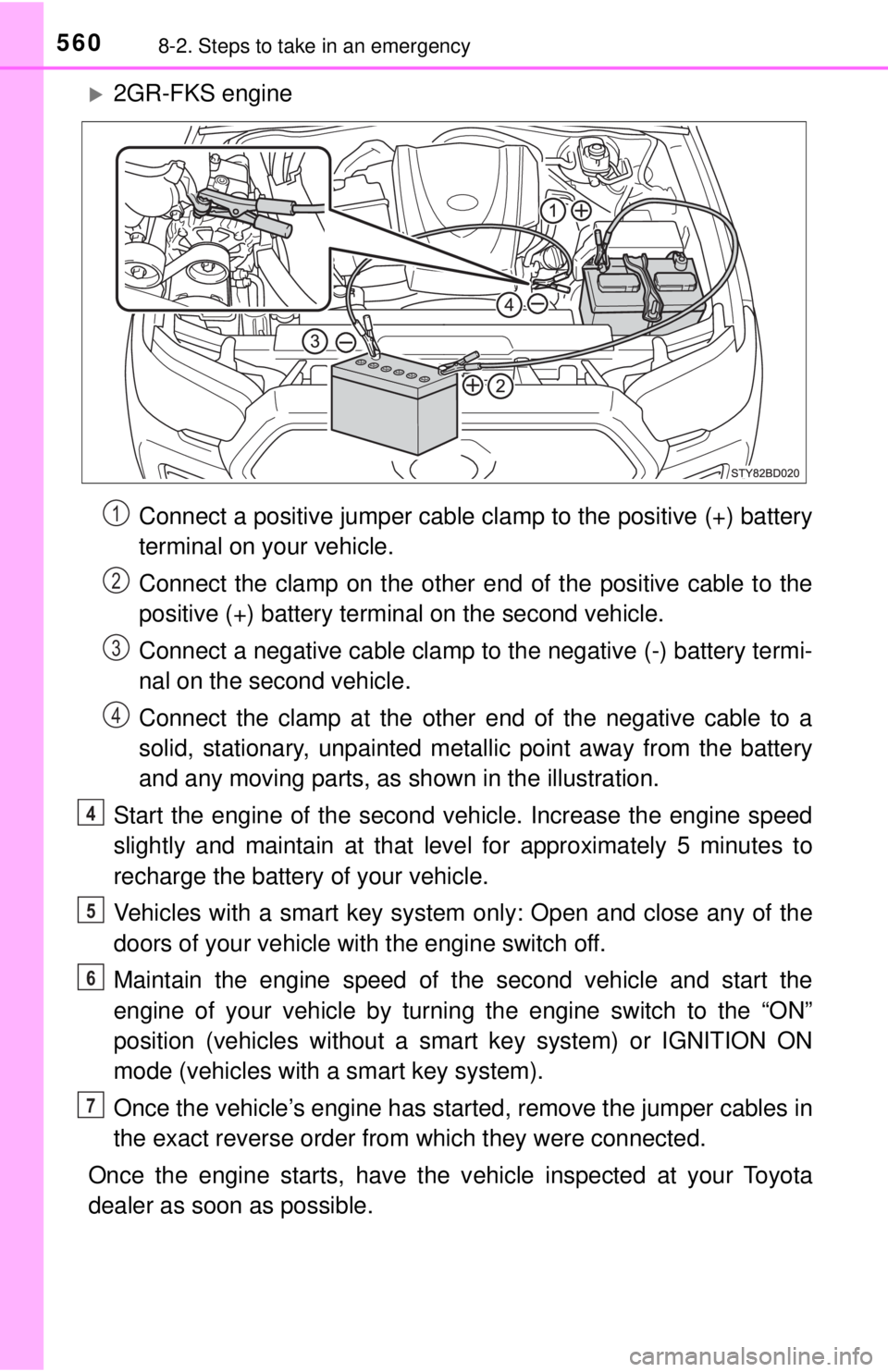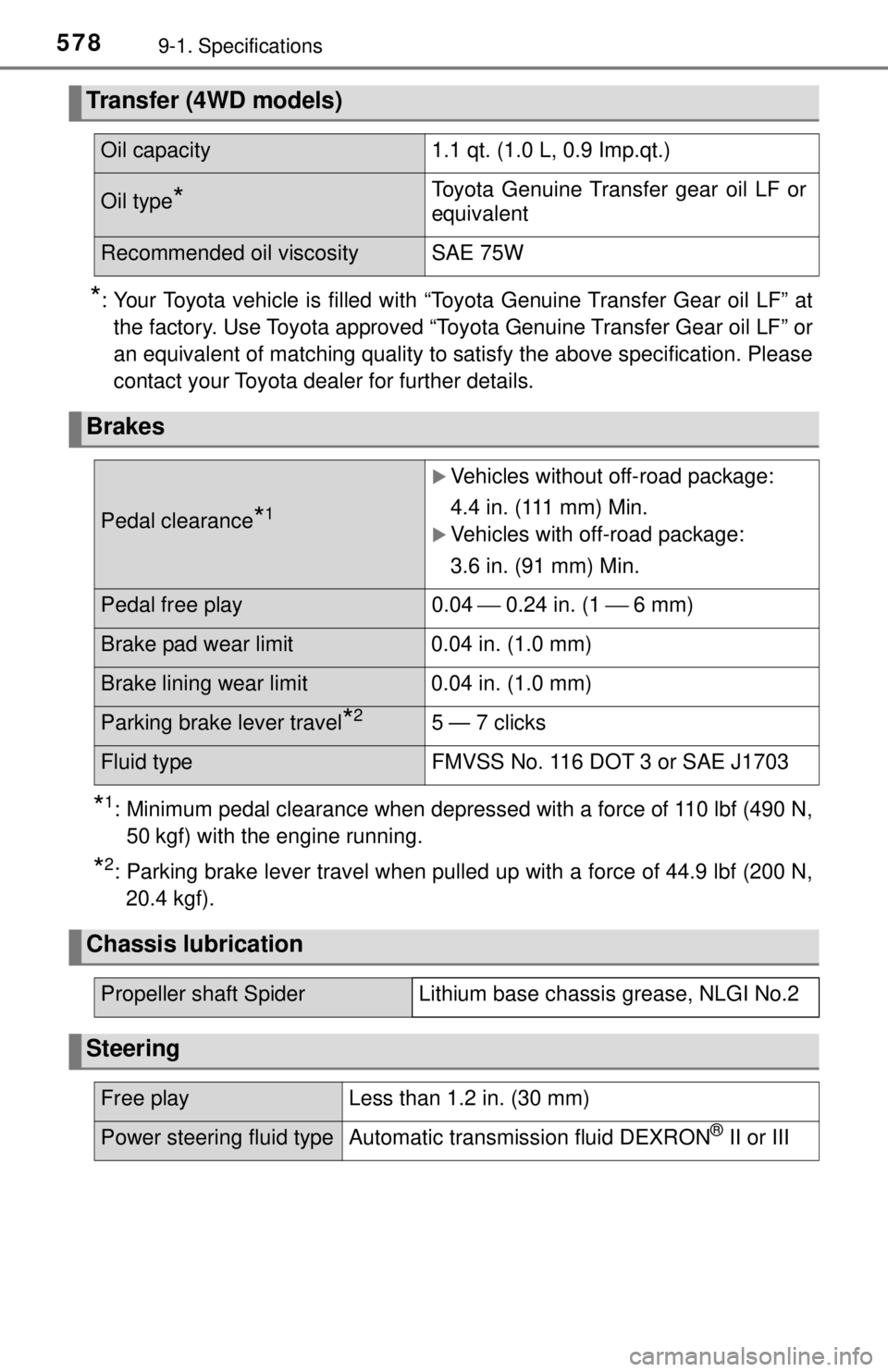Page 535 of 640
5358-2. Steps to take in an emergency
8
When trouble arises
Once3 times
The driver’s door was opened
and closed while the elec-
tronic key was not in the vehi-
cle, the shift lever was in P
and the engine switch was not
turned off.
→Turn the engine switch
off.
→ Bring the electronic key
back into the vehicle.
The electronic key was carried
outside the vehicle and a door
other than the driver’s door
was opened and closed while
the engine switch was in a
mode other than off.
→Bring the electronic key
back into the vehicle.
OnceContin-
uous
An attempt was made to exit
the vehicle with the electronic
key and lock the doors without
first turning the engine switch
off when the shift lever was in
P.
→Turn the engine switch
off and lock the doors
again.
Interior
buzzerExterior buzzerWarning messageDetails/Actions
(Flashes)
(Displayed alternately)
(Flashes)
Page 556 of 640

5568-2. Steps to take in an emergency
One of the following may be the cause of the problem:
●One or both of the battery terminals may be disconnected.
● The battery may be discharged. ( →P. 559)
● There may be a malfunction in the steering lock system (vehicles
with a smart key system).
Contact your Toyota dealer if the problem cannot be repaired, or if repair
procedures are unknown.
When the engine does not start, the following steps can be used as an
interim measure to start the engine if the engine switch is functioning
normally:
Set the parking brake.
Shift the shift lever to P.
Turn the engine switch to ACCESSORY mode.
Press and hold the engine switch for about 15 seconds while
depressing the brake pedal firmly.
Even if the engine can be started using the above steps, the system
may be malfunctioning. Have the ve hicle inspected by your Toyota
dealer.
The starter motor does not turn over, the interior lights and head-
lights do not turn on, or the horn does not sound.
Emergency start function (vehicles with a smart key system)
1
2
3
4
Page 558 of 640
5588-2. Steps to take in an emergency
■Stopping the engine
Shift the shift lever to P and press the engine switch as you normally do when
stopping the engine.
■ Replacing the key battery
As the above procedure is a temporary measure, it is recommended that the
electronic key battery be replaced immediately when the battery is depleted.
(→P. 485)
■ Changing engine switch modes
Within 10 seconds of the buzzer sounding, release the brake pedal and press
the engine switch.
The engine does not start and modes will be changed each time the switch is
pressed. ( →P. 193)
Page 560 of 640

5608-2. Steps to take in an emergency
2GR-FKS engineConnect a positive jumper cable clamp to the positive (+) battery
terminal on your vehicle.
Connect the clamp on the other e nd of the positive cable to the
positive (+) battery terminal on the second vehicle.
Connect a negative cable clamp to the negative (-) battery termi-
nal on the second vehicle.
Connect the clamp at the other end of the negative cable to a
solid, stationary, unpainted metallic point away from the battery
and any moving parts, as shown in the illustration.
Start the engine of the second v ehicle. Increase the engine speed
slightly and maintain at that level for approximately 5 minutes to
recharge the batter y of your vehicle.
Vehicles with a smart key system only: Open and close any of the
doors of your vehicle with the engine switch off.
Maintain the engine speed of t he second vehicle and start the
engine of your vehicle by turni ng the engine switch to the “ON”
position (vehicles without a smart key system) or IGNITION ON
mode (vehicles with a smart key system).
Once the vehicle’s engine has star ted, remove the jumper cables in
the exact reverse order from which they were connected.
Once the engine starts, have the v ehicle inspected at your Toyota
dealer as soon as possible.
1
2
3
4
4
5
6
7
Page 561 of 640

5618-2. Steps to take in an emergency
8
When trouble arises
■Starting the engine when the batt ery is discharged (vehicles with an
automatic transmission)
The engine cannot be started by push-starting.
■ To prevent battery discharge
●Turn off the headlights and the audio system while the engine is off.
● Turn off any unnecessary electrical components when the vehicle is running
at a low speed for an extended period, such as in heavy traffic.
■ Charging the battery
The electricity stored in the battery will discharge gradually even when the
vehicle is not in use, due to natural discharge and the draining effects of cer-
tain electrical appliances. If the vehicle is left for a long time, the battery may
discharge, and the engine may be unable to start. (The battery recharges
automatically during driving.)
■ When recharging or replacing the battery
●Vehicles with a smart key system: In some cases, it may not be possible to
unlock the doors using the smart key system when the battery is dis-
charged. Use the wireless remote control or the mechanical key to lock or
unlock the doors.
● The engine may not start on the first attempt after the battery has recharged
but will start normally after the second attempt. This is not a malfunction.
● Vehicles with a smart key system: The engine switch mode is memorized by
the vehicle. When the battery is reconnected, the system will return to the
mode it was in before the battery was discharged. Before disconnecting the
battery, turn the engine switch off.
If you are unsure what mode the engine switch was in before the battery dis-
charged, be especially careful when reconnecting the battery.
Page 578 of 640

5789-1. Specifications
*: Your Toyota vehicle is filled with “Toyota Genuine Transfer Gear oil LF” atthe factory. Use Toyota approved “Toyota Genuine Transfer Gear oil LF” or
an equivalent of matching quality to satisfy the above specification. Pl\
ease
contact your Toyota dealer for further details.
*1: Minimum pedal clearance when depressed with a force of 110 lbf (490 N,
50 kgf) with the engine running.
*2: Parking brake lever travel when pulled up with a force of 44.9 lbf (200 N, 20.4 kgf).
Transfer (4WD models)
Oil capacity 1.1 qt. (1.0 L, 0.9 Imp.qt.)
Oil type*Toyota Genuine Transfer gear oil LF or
equivalent
Recommended oil viscosity SAE 75W
Brakes
Pedal clearance*1
Vehicles without off-road package:
4.4 in. (111 mm) Min.
Vehicles with off-road package:
3.6 in. (91 mm) Min.
Pedal free play0.04 ⎯ 0.24 in. (1 ⎯ 6 mm)
Brake pad wear limit 0.04 in. (1.0 mm)
Brake lining wear limit0.04 in. (1.0 mm)
Parking brake lever travel*25 — 7 clicks
Fluid type FMVSS No. 116 DOT 3 or SAE J1703
Chassis lubrication
Propeller shaft SpiderLithium base chassis grease, NLGI No.2
Steering
Free playLess than 1.2 in. (30 mm)
Power steering fluid typeAutomatic transmission fluid DEXRON® II or III
Page 615 of 640
615
10
For owners
Camper information
The figures given in the illustration indicate the recommended center
of gravity zone.
Recommended location for
cargo center of gravity for cargo
weight rating
Rear end of truck bed
This information has been prepared in accordance with regulation
issued by the National Highway Tr affic Safety Administration of the
U.S. Department of Transportation. It provides the purchasers and/
or prospective purchasers of Toyota vehicles with information on
truck-camper loading. Your Toyota dealer will help answer any
questions you may have as you read this information.
Center of gravity location
1
2
Access Cab models49.9 in. (1267 mm)36.1 in. (917 mm)
Double Cab models
With short deck
With long deck
41.1 in. (1045 mm)
41.5 in. (1055 mm)31.8 in. (807 mm)
27.8 in. (706 mm)
WARNING
■ Loading precaution
If a load is too far back, it can cause dangerous handling. If it is too far
forward, the front axle may be overloaded.
Page 625 of 640

625What to do if... (Troubleshooting)
●Did anyone inside the vehicle open a door during setting the alarm?
The sensor detects it and the alarm sounds. (→P. 78)
●Vehicles without a smart key system:
To stop the alarm, turn the engine switch to the “ON” position or start the
engine.
●Vehicles with a smart key system:
To stop the alarm, turn the engine switch to IGNITION ON mode or start
the engine.
●When a warning light turns on, refer to P. 514.
●When a warning light turns on or a warning message or indicator is dis-
played, refer to P. 514, 523.
●Stop the vehicle in a safe place and replace the flat tire with the spare tire.
(→P. 540)
●Try the procedure for when the vehicle becomes stuck in mud, dirt, or
snow. ( →P. 565)
An alarm is activated and the horn sounds
(vehicles with an alarm)
A warning light turns on
(vehicles without a multi-information display)
A warning light turns on or a warning message or indicator
is displayed (vehicles with a multi-information display)
When a problem has occurred
If you have a flat tire
The vehicle becomes stuck